Tour
The Panasonic RP-HC55 has boxy ear buds with an angled nozzle.
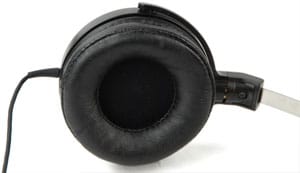
The padding is slightly triangular, with more padding toward the outside edge and less towards the inside.
The back of each bud has six holes for the active noise cancellation's microphone. The outside of the ear buds has a silvery design with some branding and an L or R to indicate the channel.
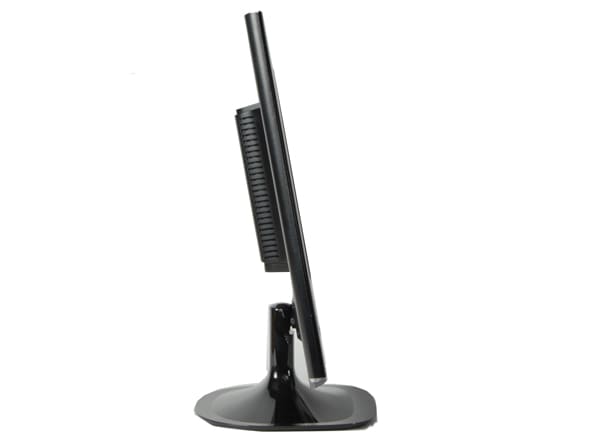
The two ear bud cables meet at a block of plastic with an adjustible neck split. After the neck split is the active cancellation control pendant.

It looks and controls like a clicky pen; you press the button on the top to turn active cancellation on and off. You can use the clip to hang the pendant off your lapel pocket, the pendant also has a volume switch. The bottom half has a hatch to conceal it's AAA battery cavity. After the pendant is a bit more cable and a standard 1/8-inch plug.
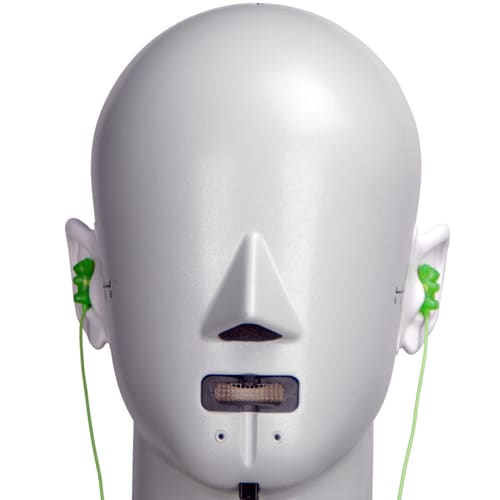
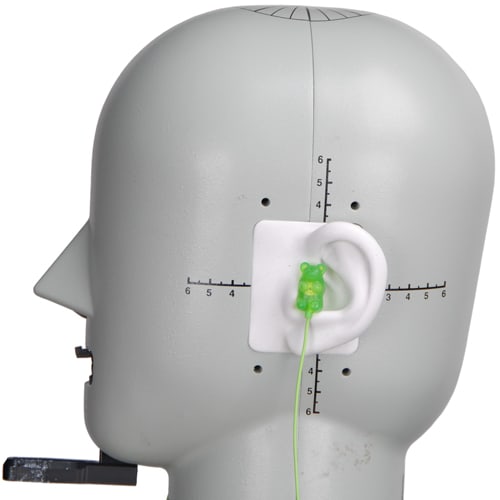
In the Box
{{section_header}}{{section.name}}{{/section_header}}
In the RP-HC55s' box you'll find the headphones, three sets of sleeves, a AAA battery, a pouch, and airplane adapter, and a cord wrap that snaps onto the back of the control pendant.
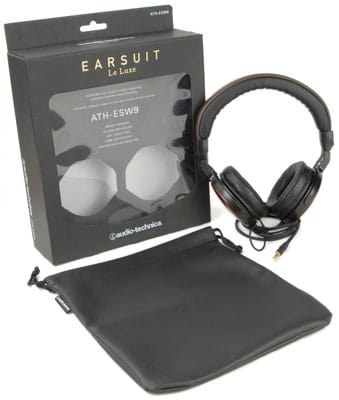
Durability
{{section_header}}{{section.name}}{{/section_header}}
The RP-HC55 headphones seem durable enough. They have good cord guards, although the in-line pendant means there's two more cord guards then typical. Cord guards stop the cable from bending sharply against whatever hard object it's projecting from. Sharp bends equal wear and tear damage (just ask the original Vibe Duo, which was quietly updated to add in better cord guards).
Another issue we found, which is related to durability, is how well the sleeves stay on the nozzles. In the case of the RP-HC55s, the sleeves could've clung on better. They didn't pop off to become lost on the streets of Boston or anything, but they do have a slightly looser fit than we would've liked.
Aesthetics
{{section_header}}{{section.name}}{{/section_header}}
These headphones have some severe disadvantages when it comes to aesthetics. First of all, as in-ears, the RP-HC55s don't have a lot of room to impress us. The ear buds themselves are good looking enough, but where we really had a problem was with the control pendant. Like the Audio-Technica ATH-ANC3s, the active cancellation pendant is a bit bulky. The difference between the two headphones, however, is the placement of the control pendant. The ATH-ANC3s place their pendant towards the end of the cord so you can shove it in your pocket. It's out of the way, but still accessible, and no one has to look at it. The RP-HC55s' pendant will only reach your front pocket if you're short. The only real option for dealing with a giant pen slapping you in the xyphoid process all day is to clip it to some part of your shirt, likely your lapel pocket.

Summary
{{section_header}}{{section.name}}{{/section_header}}
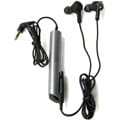
The Panasonic RP-HC55s are a set of in-ear active noise cancellers. The actual MSRP is $100, but you can find them for about $60 if you look around. This price point makes the RP-HC55s the least expensive set of active-cancellers we've reviewed to date. One of the first things you'll notice about the RP-HC55s is their control pendant. Although we go into a lot of detail in the review about why we think the pendant could have been implemented better, we will say that it needlessly creates comfort and portability issues.
Frequency Response
{{section_header}}{{section.name}}{{/section_header}}
We found that the Panasonic RP-HC55 performs ok overall, but has some issues with underemphasis. The curve starts out fine. The bass has an interesting curve, emphasizing the low end, dipping down a bit, then coming back up again. After that peak, which is somewhere around 700Hz, both channels decrease steadily past the bottom limit. Any of the frequencies that occur under the bottom limit could sound a bit soft. The left channel dips down a bit further than we'd like to see, but again, the difference won't be jarring. The left channel, overall, is ever so slightly louder than the right channel, but a uniform error like this one could be due to a minor fit issue.
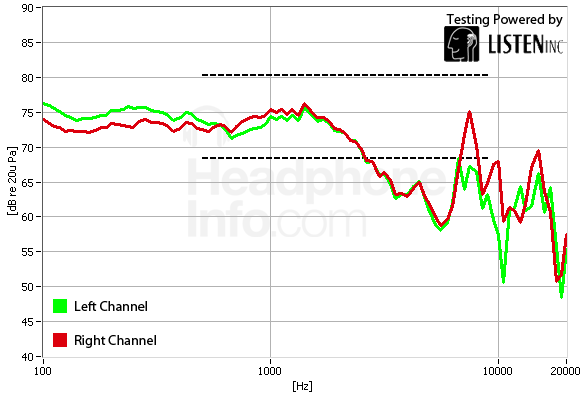
Since the RP-HC55s are the second set of active-cancelling in-ear headphones we've reviewed, we can now say, with the confidence only sweeping generalization can bring, that all such headphones have a poor frequency response. Actually, although the RP-HC55s and ATH-ANC3s have similar scores, you an see that they have very different response curves. While the RP-HC55 tends to underemphasize the area between 1kHz and 10kHz, the ATH-ANC3 pumps it past the top limit.
The RP-HC55 Finds itself in the top half of the comparison phones in terms of a score. The two that did better, the SE420 and MM 50 iP, are both (currently) in the top five on our ratings table (being #5 and #1 respectively), so the RP-HC55 shouldn't feel too bad about falling a bit behind them.
Distortion
{{section_header}}{{section.name}}{{/section_header}}
If you take someone who's never bought headphones before, showed them this trend and only told them it was a graph of distortion, they'd point to the spike at the end and say, 'so that's bad, right?' As we said in this test's intro, anything over 3% is noticeable. This line comes close to 4%, which is bad. Of course, the spike only encompasses a tiny range, but the distortion therein is significant. This being said, we were impressed with teh low levels of distortion elsewhere. This spike is likely an unfortunate side-effect of the active noise cancellation.
This result is the norm for active-cancellers. Out of all the headphones we test, active-cancellers generally have poor distortion tests. Of course, there are exceptions and some headphones actually have very little distortion when their noise cancellation is turned off (high-five, Denon AH-NC732). The reason for this is that active cancellation works by playing back sounds that aren't really there. Some will cancel out background noise as intended, but invariably some won't.
Since the RP-HC55s can't turn off their active cancellation, you're stuck with this distortion spike.
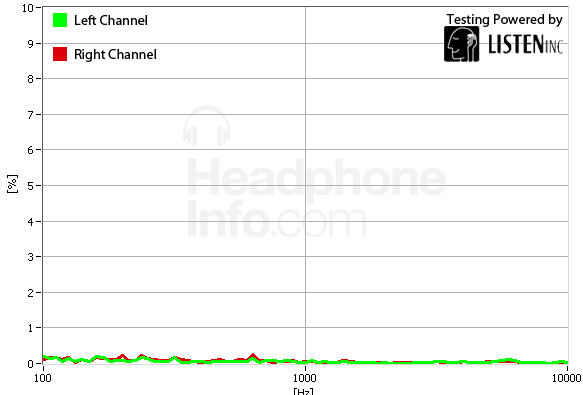
The RP-HC55 does about as well as the ATH-ANC3, a fellow active-canceller. The AH-NC732 is also an active-canceller, but it can switch its cancellation off, netting an absurdly low distortion score. A score like the RP-HC55s basically means you don't necessarily care all that much about distortion. This is likely to be the case, since both the in-ear form factor and active noise cancellation feature mean you're probably taking these headphones outside, where things are noisy. These headphones are not for audiophiles.
Tracking
{{section_header}}{{section.name}}{{/section_header}}
As we saw on the frequency response graph, the right channel is a bit louder than the left. Again, this could be a small fit issue; in any case, small changes like this don't really affect the score. The troubling bit is towards the high end, where the response gets crazy a bit faster than it should have.
One thing we should mention is that, while the emphasis on the right channel could be a fit issue (the change is pretty uniformly skewed towards one side), we did notice that, throughout our tests, the right channel tended to be louder than the left. The graph pictured at right represents the best score we were able to achieve, despite it being a bit off-kilter. The take-away from this score probably isn't that the right channel is louder, but rather that positioning the ear buds matters.
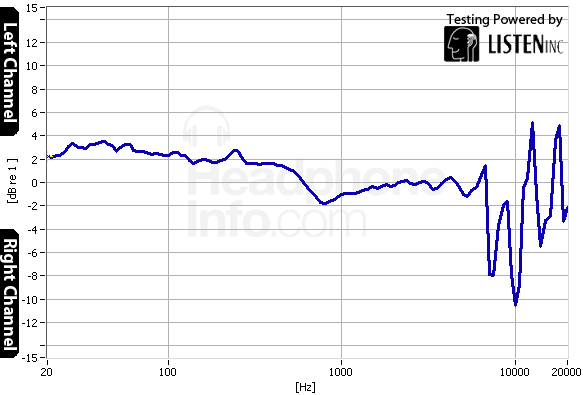
The RP-HC55 didn't do half bad on this test. It did better than the AH-NC732, which is our current poster child for active-cancellation done right. It didn't fare well compared to other headphones, however, since its jumps from left to right were a bit more severe than other headphones pictured below. If you'll notice, most headphones tend to have a relatively straight line up until about 10kHz, at which point the graph gets all jumbly.
Maximum Usable Volume
{{section_header}}{{section.name}}{{/section_header}}
The RP-HC55 was actually capable of an impressive volume level given its poor distortion score. We were able to squeeze 118.58 decibels out of it, which is less than 2 dB from the max level we award points for. Anything past 120dB is just going to be harmful, and we here at HeadphoneInfo.com care about your health. Unless you have difficulties hearing to begin with, 120dB should be plenty.
Isolation
{{section_header}}{{section.name}}{{/section_header}}
The RP-HC55s actually performed quite well here. The active cancellation blocked out a big chunk of bass noise, which is typically all that active cancellation is good for. It also managed to block out a bit of the mid-to-high sounds as well, which was a nice bonus. Further, it appears the active cancellation never added more noise than it reduced. We could definitely hear a high-pitched whine when we turned on cancellation in a quiet room, which is why we were a bit surprised to see the blue line didn't dip below the green one towards the high end. Although that whine might annoy you under ideal listening conditions, we never noticed it when we hit the streets, which is where you're supposed to be wearing these things anyway.
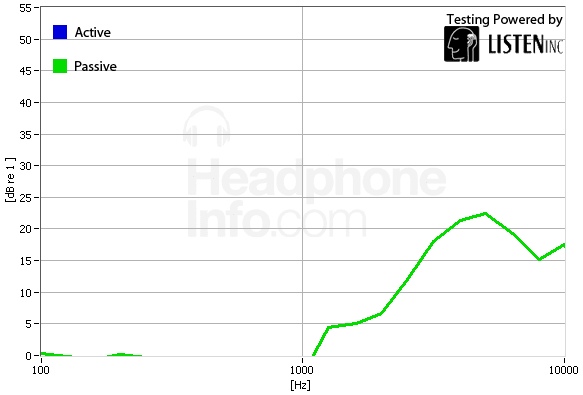
Our ATH-ANC3 hypothesis has been destroyed: it seems like active cancellation can succeed to some extent in a pair of in-ears. This didn't score as well as a great pair of in-ears, like the SE420, so the technology probably could've been obviated by a nice pair of foam plugs. The ATH-ANC3 does block out more bass sound than the SE420s do, but only by a bit.
Leakage
{{section_header}}{{section.name}}{{/section_header}}
As expected, these headphones weren't the best at controlling leakage. They weren't bad compared to all headphones, but for a set of in-ears they weren't good. The performance has to do with how active cancellation works. Since it requires a microphone to listen to outside noise, the headphones require tiny holes to be punched in their plastic casing. This lets sound transfer in and out of the headphones more easily (as evidenced by the poor passive isolation score above). Of course, since you'll feel isolated from your surroundings due to the active cancellation, it's hard to gauge how much sound is leaking out of your headphones. The RP-HC55s didn't leak as much as Audio-Technica's ATH-ANC3s, but they weren't nearly as good as a set of regular in-ear headphones.
Short-Term Use
{{section_header}}{{section.name}}{{/section_header}}
There are two caveats to this score. The first is our typical, 'it's likely your head isn't as horribly misshapen as that of our reviewer, so trust your own judgment over this write-up' spiel. The second pertains to the active noise cancellation pendant. If you're around 5 feet tall, then the pendant will probably reach your front pocket, but we wouldn't count on it. Otherwise, you'll need to tether the pendant to your shirt somehow. If you don't or can't, then the pendant will flop around and pull on the ear buds. We thought a good strategy to combat the flopping would just be to zip up a jacket/hoodie/vest over the pendant to hold it still. This worked a bit, but the weight from the pendant still pulled on the ear buds, only now the cord rubbed against the garment we were wearing over the headphones. The combination of this extra friction and gravity's assault on the battery-carrying pendant meant the ear buds would easily pull out of our ears. The best solution is to tether the pendant (reduces pulling) and then wear something over the cord (reduces flopping). If you do this, the RP-HC55s would be an average set of in-ears as far as comfort's concerned. Other in-ear headphones don't have these crazy issues, not even the ATH-ANC3s, which also have an active cancellation pendant.
The earbuds themselves weren't particularly uncomfortable, but the pendant is simply located in an awkward place. Though these weren't the worst headphones we've had to put on, but the restrictions for a comfortable fit certainly hurt the RP-HC55s here.
Extended Use
{{section_header}}{{section.name}}{{/section_header}}
The same issues from above applied here. The headphones themselves didn't get any less comfortable over time, most likely due to the thin sleeves not putting a lot of pressure on our inner ear. The pendant just creates an awkward situation.
Cable Connectivity
{{section_header}}{{section.name}}{{/section_header}}
The total distance from ear bud to plug, including the control pendant, is 4 feet, 8.75 inches (1.44m). This is a bit longer than the average set of in-ears, but not by a great margin. The cable ends in a standard 1/8-inch plug.
An airplane adapter is also included. These aren't the most well-connected in-ears we've seen, but for they're price they're definitely above average.

These are the two cords that come in the box. It would've been nice to have a male-to-male connector to form one long cord, but alas, we do not live in such a world.
Customizability
{{section_header}}{{section.name}}{{/section_header}}
There really aren't many ways to customize your RP-HC55 wear experience. The headphones come with the standard small, medium, and large soft plastic sleeves. There's also an adjustable neck split. Other than these features, however, there aren't many options available. Sometimes in-ears come with more sleeve options, and a few come with a jack split part way down the cable, so you can plug in a volume control or another accessory.
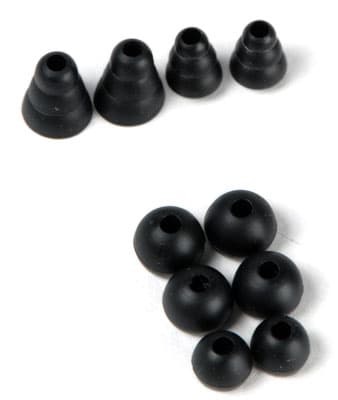
Portability
{{section_header}}{{section.name}}{{/section_header}}
In-ears are typically very portable, but the RP-HC55s are a bit of an exception. The control pendant is a bit big, and even though it allows you to snap on a cord wrap to keep your headphones organized, these are going to take up more room in your pocket than the average set of in-ears.
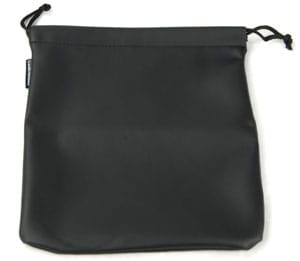
The pouch doesn't have any inner pockets or cord-managing features, so it's not particularly helpful.
While the cord wrap is a nice inclusion, we're not fans of including little pouches as a carrying case. We like somewhat rigid cases with internal pockets, since they both offer protection and optimal organization.

The pouch doesn't have any inner pockets or cord-managing features, so it's not particularly helpful.
Maintenance
{{section_header}}{{section.name}}{{/section_header}}
We have yet to review a pair of in-ears that let you disassemble them to any degree. Sure, you can remove the sleeves for easier cleaning, but that's about the extent of it. There is no cleaning tool included, there's no removable wax guards, and there's no duplicate sleeves included in case you lose a set.
Other Features
{{section_header}}{{section.name}}{{/section_header}}
Battery
The RP-HC55s can't play back music when their battery is dead, which is something we wish we'd see less of. A lot of headphones nowadays are making the active cancellation an optional feature, allowing you to use your headphones to listen to music sans cancellation even after its batteries have died.
These gripes aside, the headphones have a stupid long battery life, however. One AAA will get you about 110 hours (4.5 days!) of continuous noise cancellation. This is an absurdly long battery life, which is especially nice since you'll need to keep feeding these things AAAs to keep them going. A 4-pack will last you for almost a month of non-stop cancellation.

This is the battery port, which accepts one AAA.
Volume Control
The side of the RP-HC55s' control pendant has a volume switch. Depending on the media source you're hooked up to, this could be a pretty useful feature. It's also good if your music isn't all volume normalized.

Active Noise Cancellation
The RP-HC55s don't have particulary good implementation of their active noise cancellation feature. For starters, the headphones have a single on/off button that controls both power and active noise cancellation. As mentioned above, many newer active-cancellers will let you switch the feature on and off, which will let you conserve batteries for when you actually need active cancellation. Many active-cancellers will also play back music without battery backup.
Plus, the pendant's shape and red LED mean that, while turning your music off or on, there's a chance some overly-dramatic onlooker will think you're trying to detonate a bomb. We're not sure if this is a good or bad thing. We're guessing bad in most cases.

Value
{{section_header}}{{section.name}}{{/section_header}}
The RP-HC55 isn't particularly spectacular, but it is solid for a set of in-ears that'll run you about $60. Again, the main problem we ran into was the awkward positioning of the pendant, so if that doesn't bother you, you're really keen on active noise cancellation, and you want a pair of headphones for under $100, the RP-HC55s aren't that bad a choice.
Conclusion
{{section_header}}{{section.name}}{{/section_header}}
The RP-HC55s aren't spectacular headphones. In fact, they have some issues with comfort since the control pendant is downright awkward. This being said, if the pendant doesn't annoy you, these are a very inexpensive set of active-cancelling in-ears. They'll let you get the isolation capabilities of a higher-end set without having to pay the price. If you're a commuter and don't mind dealing with the pendulous movements of the control pendant, or always have a shirt pocket to keep the thing clipped in place, then they're really not a bad choice. No, they don't have the best audio quality out there, but the same could be said for most in-ears and active-cancellers. Really, these are meant to be portable, and going outside means competing with loud, low, ambient noise.
Meet the tester
Mark Brezinski works on the Home Team, reviewing refrigerators, minifridges, dishwashers, washing machines, dryers, air conditioners, air purifiers, and fans.
Checking our work.
Our team is here to help you buy the best stuff and love what you own. Our writers, editors, and experts obsess over the products we cover to make sure you're confident and satisfied. Have a different opinion about something we recommend? Email us and we'll compare notes.
Shoot us an email